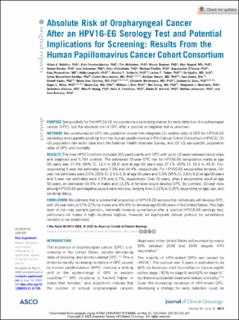| dc.contributor.author | Robbins, Hilary A. | |
| dc.contributor.author | Ferreiro-Iglesias, Aida | |
| dc.contributor.author | Waterboer, Tim | |
| dc.contributor.author | Brenner, Nicole | |
| dc.contributor.author | Nygård, Mari | |
| dc.contributor.author | Bender, Noemi | |
| dc.contributor.author | Schroeder, Lea | |
| dc.contributor.author | Hildesheim, Allan | |
| dc.contributor.author | Pawlita, Michael | |
| dc.contributor.author | D'Souza, Gypsyamber | |
| dc.contributor.author | Visvanathan, Kala | |
| dc.contributor.author | Langseth, Hilde | |
| dc.contributor.author | Schlecht, Nicolas F. | |
| dc.contributor.author | Tinker, Lesley F. | |
| dc.contributor.author | Agalliu, Ilir | |
| dc.contributor.author | Wassertheil-Smoller, Sylvia | |
| dc.contributor.author | Ness-Jensen, Eivind | |
| dc.contributor.author | Hveem, Kristian | |
| dc.contributor.author | Grioni, Sara | |
| dc.contributor.author | Kaaks, Rudolf | |
| dc.contributor.author | Sánchez, Maria-Jose | |
| dc.contributor.author | Weiderpass, Elisabete | |
| dc.contributor.author | Giles, Graham G. | |
| dc.contributor.author | Milne, Roger L. | |
| dc.contributor.author | Cai, Qiuyin | |
| dc.contributor.author | Blot, William J. | |
| dc.contributor.author | Zheng, Wei | |
| dc.contributor.author | Weinstein, Stephanie J. | |
| dc.contributor.author | Albanes, Demetrius | |
| dc.contributor.author | Huang, Wen-Yi | |
| dc.contributor.author | Freedman, Neal D. | |
| dc.contributor.author | Kreimer, Aimée R | |
| dc.contributor.author | Johansson, Mattias | |
| dc.contributor.author | Brennan, Paul | |
| dc.date.accessioned | 2023-05-15T13:18:16Z | |
| dc.date.available | 2023-05-15T13:18:16Z | |
| dc.date.created | 2022-11-15T14:29:41Z | |
| dc.date.issued | 2022 | |
| dc.identifier.citation | Journal of Clinical Oncology. 2022, 40 (31), 3613-3622. | en_US |
| dc.identifier.issn | 0732-183X | |
| dc.identifier.uri | https://hdl.handle.net/11250/3067972 | |
| dc.description.abstract | PURPOSE
Seropositivity for the HPV16-E6 oncoprotein is a promising marker for early detection of oropharyngeal cancer (OPC), but the absolute risk of OPC after a positive or negative test is unknown.
METHODS
We constructed an OPC risk prediction model that integrates (1) relative odds of OPC for HPV16-E6 serostatus and cigarette smoking from the human papillomavirus (HPV) Cancer Cohort Consortium (HPVC3), (2) US population risk factor data from the National Health Interview Survey, and (3) US sex-specific population rates of OPC and mortality.
RESULTS
The nine HPVC3 cohorts included 365 participants with OPC with up to 10 years between blood draw and diagnosis and 5,794 controls. The estimated 10-year OPC risk for HPV16-E6 seropositive males at age 50 years was 17.4% (95% CI, 12.4 to 28.6) and at age 60 years was 27.1% (95% CI, 19.2 to 45.4). Corresponding 5-year risk estimates were 7.3% and 14.4%, respectively. For HPV16-E6 seropositive females, 10-year risk estimates were 3.6% (95% CI, 2.5 to 5.9) at age 50 years and 5.5% (95% CI, 3.8 to 9.2) at age 60 years and 5-year risk estimates were 1.5% and 2.7%, respectively. Over 30 years, after a seropositive result at age 50 years, an estimated 49.9% of males and 13.3% of females would develop OPC. By contrast, 10-year risks among HPV16-E6 seronegative people were very low, ranging from 0.01% to 0.25% depending on age, sex, and smoking status.
CONCLUSION
We estimate that a substantial proportion of HPV16-E6 seropositive individuals will develop OPC, with 10-year risks of 17%-27% for males and 4%-6% for females age 50-60 years in the United States. This high level of risk may warrant periodic, minimally invasive surveillance after a positive HPV16-E6 serology test, particularly for males in high-incidence regions. However, an appropriate clinical protocol for surveillance remains to be established. | en_US |
| dc.language.iso | eng | en_US |
| dc.publisher | American Society of Clinical Oncology | en_US |
| dc.rights | Attribution-NonCommercial-NoDerivatives 4.0 Internasjonal | * |
| dc.rights.uri | http://creativecommons.org/licenses/by-nc-nd/4.0/deed.no | * |
| dc.title | Absolute Risk of Oropharyngeal Cancer After an HPV16-E6 Serology Test and Potential Implications for Screening: Results From the Human Papillomavirus Cancer Cohort Consortium | en_US |
| dc.title.alternative | Absolute Risk of Oropharyngeal Cancer After an HPV16-E6 Serology Test and Potential Implications for Screening: Results From the Human Papillomavirus Cancer Cohort Consortium | en_US |
| dc.type | Peer reviewed | en_US |
| dc.type | Journal article | en_US |
| dc.description.version | publishedVersion | en_US |
| dc.source.pagenumber | 3613-3622 | en_US |
| dc.source.volume | 40 | en_US |
| dc.source.journal | Journal of Clinical Oncology | en_US |
| dc.source.issue | 31 | en_US |
| dc.identifier.doi | 10.1200/JCO.21.01785 | |
| dc.identifier.cristin | 2074368 | |
| cristin.ispublished | true | |
| cristin.fulltext | original | |
| cristin.qualitycode | 2 | |

